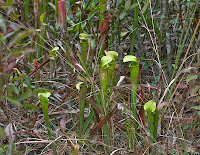 Flashback to the last ice age -- as the cold and ice pushed southward, animal and plant species did so too. Many of them, from the southeastern swamps, the eastern forests, the central plains, and the southwestern deserts ended up coexisting in East Texas in an area called the "Big Thicket." At first glance the Big Thicket looks like any other jumble of underbrush interspersed with trees, but inside the thickets are orchids, carnivorous plants, palmettos, pines, and deciduous trees. Bluebirds and roadrunners co-exist, and even the Ivory Billed Woodpecker was reportedly seen here as late as 1971.
Flashback to the last ice age -- as the cold and ice pushed southward, animal and plant species did so too. Many of them, from the southeastern swamps, the eastern forests, the central plains, and the southwestern deserts ended up coexisting in East Texas in an area called the "Big Thicket." At first glance the Big Thicket looks like any other jumble of underbrush interspersed with trees, but inside the thickets are orchids, carnivorous plants, palmettos, pines, and deciduous trees. Bluebirds and roadrunners co-exist, and even the Ivory Billed Woodpecker was reportedly seen here as late as 1971.
 There are lots of hiking trails here, and we opted for a one-mile hike called the Pitcher Plant Trail. Let me emphasize -- I hiked a mile. That's the most I've done since the ankle break! It felt really good to get out in nature, even though this particular part of nature was outfitted with quarter-mile boardwalk!
There are lots of hiking trails here, and we opted for a one-mile hike called the Pitcher Plant Trail. Let me emphasize -- I hiked a mile. That's the most I've done since the ankle break! It felt really good to get out in nature, even though this particular part of nature was outfitted with quarter-mile boardwalk!
 The boardwalk snaked through a bog filled with fields of pitcher plants, one of four carnivorous plants found in the Big Thicket (the only carnivorous plant NOT found here is the Venus Flytrap). To capture its meal, the pitcher plant secrets a scent that is appealing to insects. When they go to investigate, they can easily stand on the top edge of the plant, where the attractive scent lures them further into the tube. As they move downwards, hairs inside the plant get more slippery and begin pointing downward, providing a barrier to escape. Soon the insect is not able to get a foothold, and eventually falls into the bottom of the tube where enzymes begin to digest the meal.
The boardwalk snaked through a bog filled with fields of pitcher plants, one of four carnivorous plants found in the Big Thicket (the only carnivorous plant NOT found here is the Venus Flytrap). To capture its meal, the pitcher plant secrets a scent that is appealing to insects. When they go to investigate, they can easily stand on the top edge of the plant, where the attractive scent lures them further into the tube. As they move downwards, hairs inside the plant get more slippery and begin pointing downward, providing a barrier to escape. Soon the insect is not able to get a foothold, and eventually falls into the bottom of the tube where enzymes begin to digest the meal.

In addition to the pitcher plants, we saw lizards, butterflies, a dragonfly, and this praying mantis -- a very cooperative one who didn't mind sitting on my leg for a portrait. There were numerous flies, who sometimes landed on the lip of the pitcher plants, but we never saw one fall in. A few mosquitoes, a crow or two, and a black snake crossing the road were the only other fauna we saw -- but there are a lot of trails here, and I'd like to make return visits to see what else might be lurking in the thickets.

2 comments:
What a wonderful place. For the ten years that I lived in Houston, the Big Thicket was often my destination on weekends to chase dragonflies and other insects. Great country but unfortunately no longer home to the Ivory-billed Woodpecker. However, it still has the Red-cockaded Woodpecker which is a federally listed endangered species and well worth the effort to find.
Glad to hear you are out and about and hiking again. Are you going to be out to AZ or Quartzsite this winter?
Post a Comment